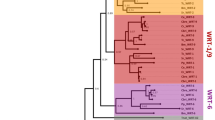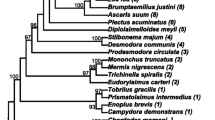Abstract
We have analysed the evolution ofERG28/C14orf1, a gene coding for a protein involved in sterol biosynthesis. While primary sequence of the protein is well conserved in all organisms able to synthesize sterolsde novo, strong divergence is noticed in insects, which are cholesterol auxotrophs. In spite of this virtual acceleration, our analysis suggests that the insect orthologues are evolving today at rates similar to those of the remaining members of the family. A plausible way to explain this acceleration and subsequent stabilization is that Erg28 plays a role in at least two different pathways. Discontinuation of the cholesterogenesis pathway in insects allowed the protein to evolve as much as the function in the other pathway was not compromised.
Similar content being viewed by others
References
Blais C., Dauphin-Villemant C., Kovganko N., Girault J. P., Descoins C. and Lafont R. 1996 Evidence for the involvement of 3-oxo-D4 intermediates in ecdysteroid biosynthesis.Biochem. J. 320, 413–419.
Dauphin-Villemant C., Bocking D., Blais C., Toullec J. Y. and Lafont R. 1997 Involvement of a 3\-hydroxysteroid dehydrogenase activity in ecdysteroid biosynthesis.Mol. Cell. Endocrinol. 128, 139–149.
Gachotte D., Eckstein J., Barbuch R., Hughes T., Roberts C., and Bard M. 2001 A novel gene conserved from yeast to humans is involved in sterol biosynthesis.J. Lipid Res. 42, 150–154.
Hughes T., Marton M. J., Jones A. R., Roberts C. J., Stoughton R., Armour C. D., Bennett H. A., Coffey E., Dai H., He Y. D., Kidd M. J., King A. M., Meyer M. R., Slade D., Lum P. Y., Stepaniants S. B., Shoemaker D. D., Gachotte D., Chakraburtty K., Simon J., Bard M. and Friend S. H. 2000 Functional discovery via a compendium of expression profiles.Cell 102, 109–126.
Konig A., Happle R., Bornholdt D., Engel H. and Grzeschik K. H. 2000 Mutations in the NSDHL gene, encoding a 3\hydroxysteroid dehydrogenase, cause CHILD syndrome.Am. J. Med. Genet. 90, 339–346.
Lees N. D., Skaggs B., Kirsch D. R. and Bard M. 1995 Cloning of the late genes in ergosterol biosynthetic pathway ofSaccharomyces cerevisiae—a review.Lipids 30, 221–226.
Ottolenghi C., Daizadeh I., Ju A., Kossida S., Renault G., Jacquet M., Fellous A., Gilbert W. and Veitia R. 2000 The genomic structure of C14orf1 is conserved across eukarya.Mamm. Genom. 11, 786–788.
Svoboda J. A. and Feldlaufer M. F. 1991 Neutral sterol metabolism in insects.Lipids 26, 614–618.
Tajima F. 1993 Simple methods for testing the molecular evolutionary clock hypothesis.Genetics 135, 599–607.
Thomas J. L., Evans B. W., Blanco G., Mason J. I. and Stricker R. C. 1999 Creation of a fully active, cytosolic form of type I 3-beta-hydroxysteroid dehydrogenase/isomerase by deletion of a membrane spanning domain.J. Mol. Endocrinol. 23, 231–239.
Thompson J. D., Gibson T. J., Plewniak F., Jeanmougin F. and Higgins D. G. 1997 The CLUSTAL_X Windows interface: flexible strategies for multiple sequence alignment aided by quality analysis tools.Nucl. Acids Res. 25, 4876–4882.
Veitia R., Ottolenghi C., Bissery M. C. and Fellous A. 1999 A novel human gene, encoding a potential membrane protein conserved from yeast to man, is strongly expressed in testis and cancer cell lines.Cytogenet. Cell Genet. 85, 217–220.
Yang Z. 1997 PAML: a program package for phylogenetic analysis by maximum likelihood.CABIOS 13, 555–556.
Author information
Authors and Affiliations
Corresponding author
Rights and permissions
About this article
Cite this article
Veitia, R.A., Hurst, L.D. Accelerated molecular evolution of insect orthologues ofERG28/C14orf1: A link with ecdysteroid metabolism?. J Genet 80, 17–21 (2001). https://doi.org/10.1007/BF02811414
Received:
Issue Date:
DOI: https://doi.org/10.1007/BF02811414




